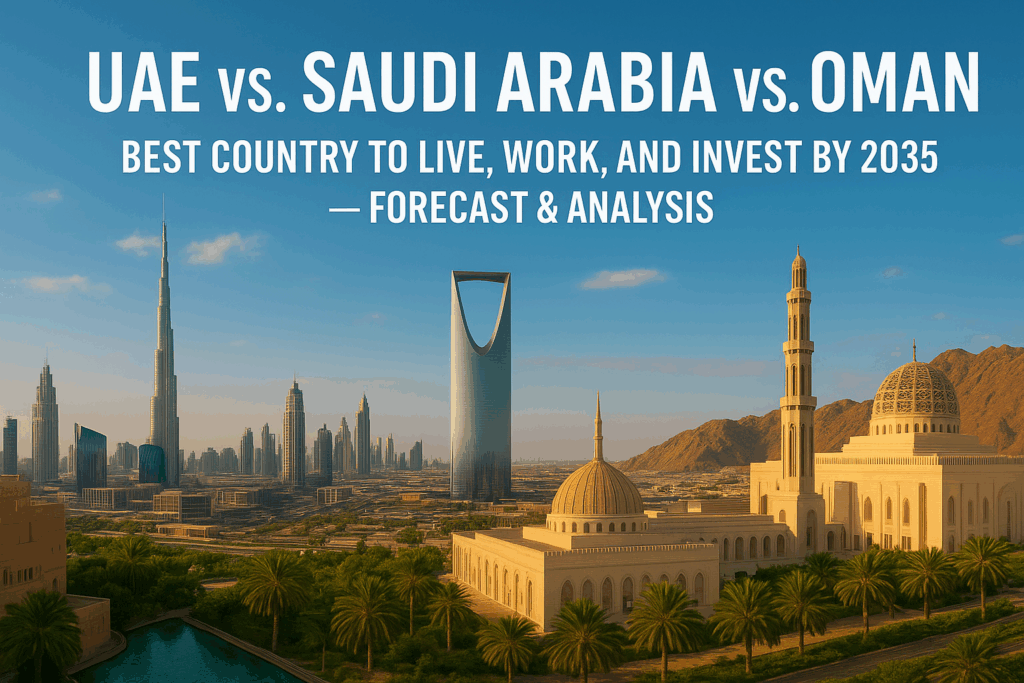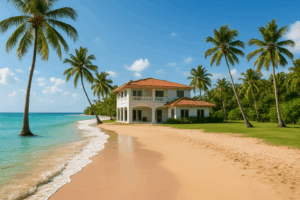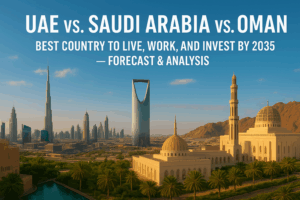UAE vs Saudi Arabia vs Oman: Best Country to Live, Work, and Invest by 2035 — Forecast & Analysis
November 22, 2025
UAE, Saudi Arabia & Oman: Possible Future Trends in Cost of Living, Lifestyle & Investment Opportunities (2025–2035 Outlook)
The Gulf region appears to be entering a phase of potentially significant transformation. Over the next decade, it is reasonable to assume that the United Arab Emirates (UAE), Saudi Arabia, and Oman may continue evolving economically, socially, and infrastructurally, gradually reshaping the everyday life of residents, expatriates, and investors. Many analysts suggest that these three countries could show different trajectories of growth, living standards, and cost structures, meaning that people planning relocation or long-term investment may benefit from exploring how these trends might unfold.Considering ongoing global developments, shifts in energy markets, and diversification strategies across the GCC, living expenses connected to housing, food, transport, and entertainment may experience changes at different speeds. Below is a projected outlook built on possible scenarios rather than fixed conclusions — a forward-looking framework that can help individuals form expectations and prepare for various outcomes.
Table of contents for the article
ToggleOverall Cost of Living Index (0 = low, 10 = very high, projected scenario)
The general cost of living may differ significantly between the three countries depending on governmental policies, urban development intensity, energy market dynamics, and international business activity. While none of the following ratings represent absolute values, they may serve as preliminary indicators of where each country could be positioned if current trends continue.
If present tendencies continue, the UAE may remain the most expensive place to live, largely due to high urban demand, luxury positioning, and active tourism flows. Saudi Arabia’s expenses could stay more moderate, although the projects under Vision 2030 might gradually influence prices. Oman might preserve a relatively affordable lifestyle, especially for families and long-term expatriates seeking quieter environments. These indicators, however, should be seen as flexible rather than fixed, since economic cycles and policy decisions could shift cost patterns.
Housing Costs: 2025–2035 Forecast (Scenario-Based Outlook)
Housing is expected to remain the most influential determinant of cost of living across the Gulf. Market forecasts suggest that rental prices, utilities, and household setup costs may change differently in each country depending on real estate supply, demand, and ongoing development strategies. Below is an expanded table presenting possible ranges for the coming decade. These figures reflect hypothetical scenarios influenced by population growth, expat inflow, real estate projects, and energy-consumption patterns.
| Category | UAE (Projected) | Saudi Arabia (Projected) | Oman (Projected) |
|---|---|---|---|
| Rent (1 BR, city center) | Potentially Very High ($1,500–$2,700) | Likely Medium ($800–$1,300) | Possibly Low–Medium ($500–$950) |
| Utilities (electricity, water, cooling) | Medium–High ($150–$260) | Likely Low ($80–$155) | Possibly Low ($70–$130) |
| Internet & Connectivity | High ($60–$110) | Medium ($40–$75) | Medium ($40–$75) |
| Furniture / Setup | High ($1,500–$2,200) | Medium ($800–$1,300) | Low ($500–$1,000) |
Judging by long-term real estate cycles, the UAE might maintain a premium housing market driven by foreign investment and continual construction of lifestyle-oriented districts. Saudi Arabia could experience a gradual rise in rental demand due to large-scale national projects such as NEOM, The Line, and various economic zones, potentially influencing rent levels in major cities. Oman may continue offering competitive rental prices while expanding suburban housing options, which could attract families and retirees seeking tranquil, nature-driven living.
Food & Groceries Costs (Forward-Looking Estimate)
Food prices in the Gulf are often shaped by external factors such as shipping expenses, import dependency, global inflation cycles, and the strength of local currencies. Because these variables fluctuate, the numbers below should be viewed as indicative estimates rather than guaranteed outcomes. Still, current patterns suggest that the UAE may remain the costliest food market, Saudi Arabia might stay in the mid-range, and Oman could continue offering comparatively moderate grocery prices.
Dining costs could follow a similar pattern. Restaurants in the UAE, especially in Dubai and Abu Dhabi, may remain on the higher side due to luxury tourism and premium imports. Saudi Arabia’s dining scene may expand significantly as entertainment reforms continue, creating a wider range of mid-priced and upscale options. Oman may keep offering more affordable, traditional dining alternatives while gradually modernizing its food scene.
Transportation: Likely Developments and Practical Costs (2025–2035)
Transport systems across the Gulf may evolve in ways that influence daily budgets, commuting choices, and long-term household planning. Below are several projected dynamics and an expanded table of possible costs to consider when planning a move or a long-term stay.
| Category | UAE (Projected) | Saudi Arabia (Projected) | Oman (Projected) |
|---|---|---|---|
| Fuel (per liter) | Possibly low due to subsidies and strategic pricing ($0.45–$0.70) | Potentially very low if domestic pricing policies persist ($0.20–$0.40) | Likely low to moderate ($0.35–$0.60) |
| Public Transport (single ride) | Could remain moderate with integrated metro/bus networks ($1–$3) | May be inexpensive in major cities but less developed in others ($0.50–$2) | Possibly low but limited in reach ($0.70–$1.80) |
| Monthly Commuter Pass | Could be $70–$150 depending on zones and city | Maybe $40–$100 in larger cities | Possibly $30–$80 where available |
| Ride-hailing (per km) | Projected $0.8–$3 per km (city & time-dependent) | Possibly $0.5–$2.5 per km | Likely $0.7–$3 per km |
| Car Purchase (compact new) | Estimated $18,000–$35,000 depending on model and taxes | Potentially $12,000–$30,000 with local market variations | Possibly $10,000–$25,000 |
In likely scenarios, the UAE could keep investing in mass transit and smart-city mobility, which may increase convenience but not necessarily reduce travel costs for premium services. Saudi Arabia’s infrastructure expansion might prioritize highway and regional links first, with urban public transport gradually catching up. Oman may continue to rely on personal vehicles in many areas, while selectively developing public transport nodes near major towns.
Lifestyle & Entertainment: Projected Accessibility and Price Ranges
Lifestyle offerings often reflect broader economic strategies. If current cultural and tourism policies persist, the following tendencies may appear across the Gulf states.
- UAE: Likely to sustain a high-density entertainment market with global-brand venues, concert tours, premium dining, and themed attractions. Expect higher ticket prices for international events but also more frequent promotions and loyalty programs.
- Saudi Arabia: Might continue a rapid expansion of entertainment districts and festivals which could create a wider price spread — from budget-friendly local events to high-end international productions.
- Oman: Could keep positioning itself as a nature and heritage destination; cultural events and eco-tourism may be priced moderately, appealing to families and visitors seeking quieter experiences.
Below is a rough expected cost guide for typical entertainment items:
- Movie ticket: UAE $8–$18; Saudi Arabia $5–$15; Oman $4–$10
- Mid-range restaurant meal (per person): UAE $20–$60; Saudi Arabia $10–$35; Oman $8–$30
- Gym membership (monthly): UAE $40–$150; Saudi Arabia $25–$90; Oman $20–$70
Healthcare & Education: Anticipated Quality and Costs
Healthcare and education are major considerations for families and long-stay residents. Projected pathways may vary by country as governments recalibrate public spending, private-sector participation, and regulatory frameworks.
Healthcare
Public healthcare systems in the Gulf may continue improving, but many expats are likely to rely on private providers for speed and perceived quality. Health insurance could become more standardized, with mandatory coverage expanding in some jurisdictions — which would influence household budgets.
- UAE: May keep high-quality private healthcare options with relatively higher out-of-pocket and insurance premiums.
- Saudi Arabia: Could expand public-private partnerships, making specialized care more accessible while keeping primary services broadly affordable.
- Oman: Might maintain a blended system where public clinics serve basic needs and private hospitals handle advanced care, at moderate costs.
Estimated typical costs (projected): GP visit $30–$80 in UAE, $15–$50 in Saudi, $10–$40 in Oman; private health insurance for a young couple could range from $700–$2,500 annually depending on coverage and country.
Education
International and private schools are likely to stay in demand. Fees could rise in high-demand urban areas but affordable public schooling and scholarships may remain available for nationals and qualifying residents.
- UAE: International schools may continue to charge premium tuition, particularly in Dubai and Abu Dhabi.
- Saudi Arabia: Could see growing investment in international-standard schools linked to expat hubs and economic zones.
- Oman: Might offer lower average tuition but with fewer premium-brand international options.
Investment Opportunities: Real Estate, Businesses, and Financial Assets (Projected)
Investment landscapes may shift as each country pursues diversification away from hydrocarbons. Below are likely opportunity areas and practical considerations for potential investors.
Real Estate
Real estate could remain attractive, but returns may vary by segment:
- UAE: High-end residential, tourism-linked short-term rentals, and commercial real estate in key districts may present opportunities — albeit with higher entry costs and competition. Regulatory clarity for foreign investors could improve, possibly encouraging more foreign capital.
- Saudi Arabia: Large-scale projects (e.g., economic cities, NEOM-adjacent developments) may open land and early-stage investment windows that could yield significant long-term gains — though these may carry higher execution and political/operational risk.
- Oman: Lower-priced residential and hospitality projects could be attractive for conservative investors seeking steady rental yield and lower volatility.
Business & Startups
If supportive policy frameworks continue, entrepreneurship ecosystems may grow:
- UAE: Likely to remain a regional hub for fintech, e-commerce, and creative industries; free zones and streamlined company formation could continue to attract founders.
- Saudi Arabia: Could present rapidly expanding domestic-market opportunities in entertainment, leisure, renewable energy, and tourism services as Vision 2030 projects advance.
- Oman: Possibly better suited for niche eco-tourism, logistics-focused SMEs, and local-service companies targeting domestic demand.
Financial Markets & Savings
Stock markets and bond issuance may offer incremental opportunities. Investors might find diversified exposure via regional ETFs and government-backed instruments. Currency stability, regulatory transparency, and taxation regimes will likely guide risk-adjusted allocations.
Regulatory, Visa & Tax Considerations (Projected)
Policy changes remain a driver of migration and investment decisions. In many scenarios, governments may continue liberalizing visa regimes to attract talent and capital while adjusting tax and subsidy policies to balance fiscal sustainability.
- UAE: Could extend long-term residency options and investor visas; tax changes seem likely to remain moderate as authorities balance competitiveness with revenue needs.
- Saudi Arabia: May increasingly open to foreign labor and capital through targeted visas and incentives aligned with megaprojects, while refining its tax and social contribution frameworks.
- Oman: Might adopt incremental residency and investor-friendly policies to attract long-term residents, especially in sectors like tourism and logistics.
Safety, Social Environment & Quality of Life (Projected)
Overall safety levels in the Gulf are likely to remain high relative to many global cities. Social norms and legal frameworks may continue evolving, with each country balancing modernization with traditional values.
- UAE may continue to be socially liberal relative to some neighbors, making it attractive to diverse expatriate communities.
- Saudi Arabia could gradually open more public spaces and cultural venues while maintaining conservative legal norms in specific areas.
- Oman is likely to preserve a relaxed, family-oriented social environment that many expatriates find welcoming and stable.
Practical Tips for Prospective Movers & Investors
- Start with a scenario-based budget: plan for a higher-than-expected first-year cost to accommodate setup, deposits, and insurance.
- Consider location premiums: city-center living is likely more expensive in the UAE and major Saudi cities; suburbs and satellite towns may be more cost-effective.
- Check visa conditions early: residency options, sponsor requirements, and business setup rules could materially affect plans.
- Build a diversified investment approach: combine real estate with liquid assets to manage risk across policy cycles.
- Prioritize health and education research: costs and quality vary widely, so early comparison shopping may save substantial money.
SEO Additions — Meta & On-Page Suggestions (for WordPress)
Below are concrete metadata and on-page suggestions that may help the article perform better in search results. Treat these as optional — they are written in a forecast tone to match the article style.
- “Dubai skyline and marina — projected urban growth”
- “Saudi city infrastructure project — possible investment zones”
- “Oman coastline and mountains — family-friendly living option”
Job Market, Salaries & Economic Prospects (2025–2035 Possible Outlook)
As the Gulf region moves through an era of rapid transformation, the job markets in the United Arab Emirates, Saudi Arabia, and Oman may experience noticeable shifts driven by digitalisation, megaproject development, and diversification beyond the energy sector. While the future cannot be predicted with certainty, several likely trends suggest that the coming decade could bring both new challenges and unprecedented opportunities for expatriates, investors, and professionals seeking long-term regional pathways. The analysis below focuses on potential salary ranges, hiring dynamics, and broader economic tendencies that may shape the labour landscape between 2025 and 2035.
Projected Average Monthly Salaries (Likely Ranges)
Salary expectations may vary significantly depending on industry, seniority, qualifications, and the economic strategies each country may follow. The numbers below represent general ranges that could emerge if the region continues on its current development trajectory.
| Sector / Position | UAE | Saudi Arabia | Oman |
|---|---|---|---|
| IT Specialist / Software Developer | $4,000–$7,000 (approx.) | $3,000–$6,000 | $2,500–$4,500 |
| Engineer (Civil / Mechanical / Electrical) | $4,500–$8,000 | $3,500–$7,000 | $2,800–$5,500 |
| Hospitality & Tourism Roles | $1,800–$3,000 | $1,500–$2,500 | $1,200–$2,000 |
| Finance / Banking Professional | $5,000–$10,000+ | $4,000–$9,000 | $3,000–$6,500 |
These salary brackets might fluctuate depending on market reforms, foreign talent policies, nationalisation strategies, and the extent to which private-sector growth will be encouraged across the region.
Possible Job Market Trends (2025–2035 Outlook)
Each country may follow a distinctive development path. Large-scale initiatives such as Saudi Vision 2030, UAE digitalisation programmes, and Oman’s Vision 2040 could strongly influence employment trends and the types of talent in demand. Below are several projections that may reflect how the job landscape evolves in each country.
- UAE may continue positioning itself as a global hub for finance, technology, logistics, and real estate innovation.
- Saudi Arabia could prioritise megaproject hiring, entertainment sector expansion, and local workforce development.
- Oman might focus on sustainable industries, tourism, environmental engineering, and small business support.
If these directions unfold as anticipated, expatriates might see demand rise for specialists in artificial intelligence, cloud systems, cybersecurity, project management, hospitality, renewable energy, and healthcare.
Investment Climate & Potential Opportunities (2025–2035 Projection)
The investment landscape across the UAE, Saudi Arabia, and Oman is likely to experience structural changes as governments continue introducing incentives aimed at foreign investors. Although the scale and speed of transformation may vary, trends indicate increasing interest in real estate, tourism, logistics, green energy, technology innovation, and manufacturing.
Real Estate Investment Forecast (Projected)
Real estate may remain one of the most attractive investment sectors in the Gulf region. Depending on policy updates, foreign ownership rules, and infrastructure expansion, each country could offer unique benefits for medium- and long-term investors.
| Country | Potential Opportunities | Projected Considerations |
|---|---|---|
| UAE | Luxury developments, waterfront districts, high-end rentals. | Prices may remain high; yields could be stable but premium-focused. |
| Saudi Arabia | New megacities, large-scale urban districts, demand from incoming workforce. | Market may expand rapidly, but early-stage volatility is possible. |
| Oman | Coastal suburban housing, eco-friendly projects, mid-range rentals. | More affordable entry point; slower but steady value growth likely. |
Technology & Innovation Sector (Possibly High Growth)
If digital transformation accelerates, the tech sector could become one of the strongest drivers of economic progress across the region. AI solutions, cybersecurity systems, fintech platforms, and automation technologies might see increased demand from both governments and private companies.
The UAE may continue as a regional leader in technology adoption and startup acceleration. Saudi Arabia could invest heavily in robotics, biotech, smart cities, and large-scale data infrastructure. Oman may strengthen digital capacity-building and encourage innovation-friendly business environments suitable for SMEs.
Tourism, Culture & Hospitality Investments
Tourism activity across the Gulf may continue expanding as countries diversify attractions, streamline visa policies, and improve infrastructure. With global travel expected to recover, hospitality investments might deliver attractive returns, especially in emerging destinations.
- UAE: Likely continued demand for luxury tourism, theme parks, and integrated hospitality concepts.
- Saudi Arabia: Significant growth potential due to megaprojects such as futuristic cities, heritage sites, and entertainment hubs.
- Oman: Strong appeal for eco-tourism, adventure experiences, and natural retreats.
If current trends persist, tourism-focused investments could generate consistent long-term interest, especially as each country seeks to develop a unique identity within the global travel industry.
Residency Systems, Visa Policies & Long-Term Stay Outlook (Projected)
The residency and visa frameworks of the United Arab Emirates, Saudi Arabia, and Oman may evolve considerably between 2025 and 2035. As each country aims to attract global talent, diversify its economy, and strengthen international competitiveness, long-term residency options could gradually expand. Although policies may shift with government priorities, several potential scenarios can be examined to help future residents and investors evaluate possible pathways for living, working, and establishing roots in the region.
Residency & Visa Comparison (Potential Outlook)
| Country | Possible Trends | Projected Advantages |
|---|---|---|
| UAE | Expansion of Golden Visa categories, potential growth in investment-based residency. | Stable rules, attractive for investors, strong global mobility, long-term security. |
| Saudi Arabia | Possible scaling of Premium Residency and skilled migrant programmes. | Access to large job market, emerging cities, tax-free salaries. |
| Oman | Gradual development of investor visas, long-term permits for property owners. | Affordable lifestyle, peaceful environment, simpler long-term stay procedures. |
If future reforms follow current regional trajectories, expats may see more flexible options for multi-year residence, especially for professionals in high-demand sectors and investors in strategic industries.
Taxation, Income Rules & Financial Obligations (Projected)
The Gulf remains known for its generally favourable tax environment, but fiscal policies may adjust as economies diversify. Though it is impossible to predict precise legislative changes, analysing current trends suggests that tax structures across the UAE, Saudi Arabia, and Oman may gradually evolve without losing competitiveness.
Projected Tax Comparison
- UAE: Likely to maintain zero personal income tax, though corporate tax frameworks may continue to expand.
- Saudi Arabia: Expected to preserve tax-free salaries for expatriates; VAT may fluctuate depending on economic targets.
- Oman: Could remain relatively low-taxed, with corporate or small business taxes gradually adjusting as needed.
Despite potential adjustments, all three countries may retain a relatively attractive fiscal structure, keeping the region appealing for high-income professionals, entrepreneurs, and remote workers.
Family Life, Education & Healthcare (Potential Outlook)
Family-oriented expatriates often evaluate schooling options, healthcare quality, safety levels, and overall child-friendly environments. Between 2025 and 2035, the Gulf region might enhance social infrastructure significantly, driven by rising populations and greater demand for international-level services.
Education Environment (Projected)
| Country | Future Outlook | Expected Cost Level |
|---|---|---|
| UAE | More international schools, advanced curriculums, EdTech adoption. | High ($8,000–$20,000/year) |
| Saudi Arabia | New private schools, increased English-medium education. | Medium ($5,000–$12,000/year) |
| Oman | Steady growth in mid-range international schools. | Medium–Low ($3,000–$9,000/year) |
If these trends continue, parents may find strong educational ecosystems developing across the region, though affordability differences will remain notable.
Healthcare Systems (Projected)
- UAE: Could remain the regional leader with advanced hospitals, telemedicine integration, and extensive insurance coverage.
- Saudi Arabia: Massive healthcare investment may lead to expanded public-private systems and improved medical tourism potential.
- Oman: Likely to offer reliable, affordable, and accessible healthcare with gradual digital modernisation.
Overall, healthcare quality across all Gulf countries may continue to rise, offering expatriates increasingly robust medical infrastructure.
Cultural Environment, Lifestyle Norms & Social Integration
Cultural experiences across the UAE, Saudi Arabia, and Oman may differ, yet all three countries could become more globally connected during the next decade. Understanding social expectations, lifestyle norms, and day-to-day habits may help future residents integrate more easily.
Projected Cultural Characteristics
- UAE: Possibly the most multicultural environment, with highly international communities and flexible social norms.
- Saudi Arabia: Rapid cultural opening may continue, with entertainment, arts, and sports sectors expanding dramatically.
- Oman: Expected to maintain a slower, more traditional pace with a strong cultural identity and high hospitality standards.
Future expatriates may find that each country offers a distinct lifestyle: UAE — fast-paced, cosmopolitan, modern. Saudi Arabia — ambitious, transformative, opportunity-driven. Oman — calm, family-oriented, environmentally rich.
Workplace Culture & Expat Integration (Projected)
Work environments in the Gulf may evolve significantly as companies adopt global management practices, remote work trends, and digital infrastructure. The next decade may see increased emphasis on merit-based hiring, international team collaboration, and advanced training programmes.
- UAE: Likely to continue operating with multinational teams, flexible contracts, and fast-moving corporate cultures.
- Saudi Arabia: Could move toward hybrid work models, structured career development, and high expectations for performance.
- Oman: Possibly offering relaxed workplaces with strong community values and stable long-term employment paths.
If current patterns persist, expats may find that professional environments across the region become increasingly aligned with global standards, promoting diversity, inclusion, and competitive career development opportunities.
Long-Term Life & Family Cost Projections (2025–2035)
Families considering relocation to the UAE, Saudi Arabia, or Oman may face a complex mix of housing, education, healthcare, and lifestyle expenses. Over the next decade, the total cost of family living could vary significantly based on location, household size, and lifestyle choices. While it is impossible to predict exact figures, potential scenarios can help prospective residents plan financially and strategically.
Estimated Annual Family Expenses (Projected)
| Category | UAE | Saudi Arabia | Oman |
|---|---|---|---|
| Housing & Utilities | $25,000–$40,000 | $12,000–$25,000 | $10,000–$20,000 |
| Education (2 children, international schools) | $20,000–$35,000 | $12,000–$22,000 | $6,000–$15,000 |
| Healthcare & Insurance | $5,000–$10,000 | $4,000–$8,000 | $3,000–$6,000 |
| Transportation & Vehicles | $6,000–$12,000 | $3,500–$7,500 | $3,000–$6,500 |
| Leisure, Entertainment, Travel | $10,000–$18,000 | $5,000–$10,000 | $3,500–$8,000 |
These projections suggest that UAE could remain the highest-cost option for families seeking luxury and high-end amenities, Saudi Arabia may offer moderate costs with expanding opportunities, and Oman could provide a cost-effective, nature-oriented family environment.
Real Estate & Housing Outlook (Projected 2025–2035)
Property markets across the Gulf may continue to evolve, influenced by foreign investment regulations, urban expansion, and population trends. Prospective buyers and renters might find differing opportunities in each country depending on location, project type, and economic policies.
Potential Residential Investment Opportunities
- UAE: High-end apartments, integrated communities, and smart city districts could offer strong long-term value, though entry costs may remain elevated.
- Saudi Arabia: Emerging residential hubs, new megacities, and government-supported housing initiatives may present growth potential for early investors.
- Oman: Coastal properties, eco-friendly developments, and mid-range housing may provide steady value appreciation with lower volatility.
If policies favour foreign property ownership and incentives continue, real estate could remain a cornerstone for investment strategies in the region.
Entrepreneurship & Business Opportunities (Projected)
Gulf countries are expected to progressively open their economies for business innovation, startups, and foreign direct investment. Predictive trends suggest a rising demand for technology-driven enterprises, logistics, renewable energy, healthcare services, and tourism-related ventures.
Business Environment (Potential Outlook)
| Country | Likely Business Focus | Projected Advantages |
|---|---|---|
| UAE | Tech startups, logistics hubs, international trade, smart city solutions | Modern infrastructure, supportive policies, access to global markets |
| Saudi Arabia | Construction, tourism, renewable energy, entertainment projects | Emerging sectors, government incentives, growing consumer base |
| Oman | Eco-tourism, small business, sustainable manufacturing, regional trade | Lower operating costs, stable legal framework, growing niche markets |
Entrepreneurs may need to evaluate local regulations, workforce availability, and potential market trends to identify optimal opportunities. Over the next decade, each country may develop specialized sectors tailored to global and regional demands.
Potential Risks & Uncertainties (2025–2035)
Even in a positive growth scenario, expatriates, investors, and families may encounter unpredictable economic, political, or regulatory changes. The following potential risks may influence cost of living, investment returns, and lifestyle quality:
- Global economic fluctuations impacting energy prices and foreign investment.
- Policy changes in visa regulations, taxation, or property ownership rules.
- Shifts in urban planning, housing demand, and infrastructure projects.
- Changes in healthcare, education, and social service costs due to population growth.
- Environmental factors, climate conditions, and sustainability policies affecting lifestyle choices.
Planning with flexibility, monitoring regional developments, and diversifying income sources may mitigate potential uncertainties over the next decade.
Comparative Summary & Future Scenarios (2025–2035)
Analyzing the projected trends across the United Arab Emirates, Saudi Arabia, and Oman reveals a complex and evolving landscape. While no forecast can guarantee absolute outcomes, several potential patterns may shape the next decade in terms of living costs, lifestyle quality, investment opportunities, and long-term residency.
Cost of Living & Lifestyle Projection
- UAE: Likely to remain the highest-cost country, especially for housing, education, and luxury consumption. However, convenience, international exposure, and premium urban amenities may compensate for elevated expenses.
- Saudi Arabia: Projected to maintain moderate costs with strong incentives for skilled professionals and growing entertainment and leisure options. Emerging cities may offer more affordable housing while providing long-term growth potential.
- Oman: Expected to provide the most cost-effective lifestyle, emphasizing safety, family orientation, and natural environment, though luxury services may be limited.
Employment & Income Outlook
Salaries across all three countries may continue reflecting economic diversification efforts. Technology, finance, healthcare, renewable energy, and tourism could remain high-demand sectors. UAE may offer the highest average wages in multinational corporations, Saudi Arabia may present rapidly expanding opportunities in emerging sectors, and Oman may favor mid-range salaries with steady cost-of-living advantages.
Investment & Real Estate Forecast
- UAE: High-end property, smart city districts, and integrated communities may remain attractive, particularly for long-term investment.
- Saudi Arabia: Potential for value growth in new megacities, residential hubs, and tourism-focused developments.
- Oman: Coastal properties and eco-friendly projects may offer stable returns with lower volatility, appealing to cautious investors.
Education, Healthcare & Family Considerations
Families may anticipate diverse options in schooling and healthcare. UAE likely continues leading in international schools and advanced healthcare, Saudi Arabia may offer expanding but moderately priced services, and Oman may maintain an affordable, reliable environment suitable for long-term residency.
Future Scenarios & Probable Trends
Considering economic, social, and policy dynamics, the Gulf region may evolve in the following ways:
- UAE: Continues as a cosmopolitan hub, attracting global talent and investors, with high living costs but premium lifestyle options.
- Saudi Arabia: Rapidly modernizing with government-led diversification, offering balanced cost of living and emerging career prospects.
- Oman: Remains calm, family-friendly, and eco-conscious, suitable for long-term residency with moderate expenses and steady economic growth.
Key Takeaways (Projected)
- High-cost vs. value: UAE may prioritize luxury and convenience, Saudi Arabia balances cost and opportunity, Oman emphasizes affordability and safety.
- Career opportunities may peak in tech, finance, renewable energy, healthcare, tourism, and real estate, but vary by country.
- Investors could benefit from UAE’s high-end market, Saudi Arabia’s emerging hubs, and Oman’s stable, eco-friendly projects.
- Families may prioritize UAE for education and medical infrastructure, Saudi Arabia for expanding urban amenities, and Oman for lifestyle and environment.
- Flexibility and long-term planning are critical due to potential policy changes, economic fluctuations, and regional development shifts.
Concluding Forecast
While future outcomes cannot be guaranteed, the Gulf region may offer a spectrum of lifestyle, investment, and career opportunities between 2025 and 2035. Individuals and families considering relocation or investment may benefit from flexible planning, diversified strategies, and careful monitoring of policy, economic, and social developments. Overall, the UAE, Saudi Arabia, and Oman may each provide unique pathways, catering to different priorities: luxury and convenience, growth and balance, or affordability and family-oriented living.





